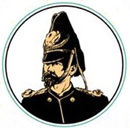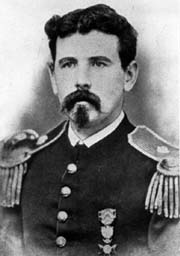
The Captain Myles Keogh Paddle, Wheel & Run
Captain Myles W. Keogh
by Jim Delaney
Home Page
Back to "History of the Great Race"
The Great Race
The Captain Myles Keogh Paddle, Wheel & Run |
Captain Myles W. Keoghby Jim Delaney |
Back to the Great Race Home Page Back to "History of the Great Race" |
| Just for Show Great Race Photos - Run Bike Canoe |

Myles Walter Keogh was a captain, commanding company I in the U. S. Seventh Cavalry under Lieutenant-Colonel George Armstrong Custer. He's now buried in Auburn's Fort Hill Cemetery, which is a long way from the dusty banks of the Rosebud River where he died along with Custer and over 200 men of the Seventh in June of 1876. It's also a long way from where Keogh was born, in the southern tip of Ireland (outside Limerick) on March 25, 1840. As the "wild geese" fly, however, it probably wasn't so far after all. The wild geese were Irish soldiers of fortune, men who made war their business, but who refused to fight under an English flag. So Keogh made his way first to Italy where he fought in the papal army and was awarded a medal for heroism in the face of overwhelming Piedmontese forces. From Italy Keogh headed to America, lured here by the opportunity the Civil War offered to a man in his profession. During the war Keogh gained a reputation for gallantry, and was brevetted a Lieutenant Colonel. George Custer was well acquainted with Keogh's prowess as a fighter. So when Custer was asked to reform the Seventh Cavalry after the war, he wanted a fighting man such as Keogh in his outfit. And that's just where Keogh wanted to be-in a fighting regiment. Well, be careful what you wish for. Keogh's long journey from home ended on Sunday, June 25, 1876, when he, and Custer, and over 200 other officers and men of the Seventh were overrun by several thousand, mainly, Sioux and Cheyenne warriors. Keogh's gallantry, noted during his career by the Pope, the U. S. Department of War, and later by Custer, was ultimately recognized by the Indian victors at the Little Bighorn, for he was the only member of the Seventh not mutilated by the Indians. We may never know why Keogh's body remained untouched. It may have been the papal medal that he always wore around his neck, or it may have been that he died like a true warrior: his pistol blazing to the last round. As one Indian survivor of the battle later said of Keogh: "Like the flame of a coal blazed his eyes. His teeth glistened like a fighting grizzly." You may also like this more detailed biography,Or this one. Back to Home PageReturn to "History of the Great Race" |
J |